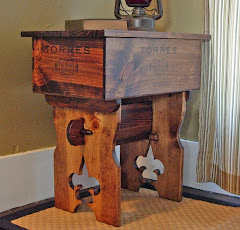This is a small coffee table I just finished. Its all of salvaged oak, red and white, mostly from shipping crates.
Its 19.5" wide, 36" long, and 18" tall. The top is about 3/4" thick, the legs 2x4 or so, and the apron about 1-1/4" thick.
It takes some work, getting those despicable spiral shank nails out of oak, but I think its worth it to get materials that are as visually and tactilely interesting as this. Also, buying clear oak in any quantity is really, really expensive.
You can see the leg closest to the camera in the above photo has some extensive boring insect damage. I made sure that it faced out so it could be seen.
Its quite heavy for its size. But I think it would work in small spaces very well.
It should probably be a well lit space. If you run into this in the dark, it won't give ground.
I used the rainwater and black walnut husk juice stain that I've used on several previous pieces. This time its a bit darker and browner though, because the juice had time to ferment over the winter. Fresh green walnut husks have a smell that I just love. I'd wear it as a cologne if anyone made it.
The fermented juice has a smell like old pipe tobacco, plus a deep forest must sort of scent. I think it's pleasant, but it doesn't linger after the stain drys.
SpareKitty assists.
Each of the apron sections has a natural wain that I turned down towards the ground. They give all sides of the table a distinct appearance. Above, the apron is much deeper on the end touching the left leg than it is on the end touching the right leg. It's a live edge on the downface and the sweeping curve draws the eye.
Friday, August 1, 2014
Friday, October 4, 2013
The Bullet Stool.
Here's one piece I won't be able to replicate. This is a black locust and cedar stool that's just a bit under bar stool height, (24"). The seat plate is a section I cut from a large locust that stood along one side of the driveway.
The tree had been dead standing for years. It's had to know how long, because black locust is nearly indestructible. There are logs that I know have been laying on the ground for thirty years out in the woods that haven't even begun to rot. The bark comes off but the wood just gets darker.
Anyway, I cut it for firewood last winter, and I thought I'd save some of it for stools. On the third pass through the log, I saw a bright spot of shiny silver metal in the wood.
I began cursing.
I thought I'd cut through a piece of old fence or rod that the tree had grown around. That ruins chainsaw chains and they aren't cheap if you use the good ones.
It didn't make sense though. The section I cut through was at least 15' from the ground when the tree was standing. So it wasn't likely to have been a fence.
I gave the metal a press with my thumbnail and it dented easily. It wasn't iron, it was lead. I had cut through a bullet that had been in that tree for who knows how long. What are the chances of cutting through a forty foot log at exactly the right spot to hit a bullet embedded in the wood?
The photo right above shows the bullet in the stool seat. It looks like maybe a .38 or so.
The seat I rubbed with walnut husk, cause I like it. The legs I left natural cedar. Three coats of finish after. The locust was very old and dry. It sucked up a lot of urethane.
The tree had been dead standing for years. It's had to know how long, because black locust is nearly indestructible. There are logs that I know have been laying on the ground for thirty years out in the woods that haven't even begun to rot. The bark comes off but the wood just gets darker.
Anyway, I cut it for firewood last winter, and I thought I'd save some of it for stools. On the third pass through the log, I saw a bright spot of shiny silver metal in the wood.
I began cursing.
I thought I'd cut through a piece of old fence or rod that the tree had grown around. That ruins chainsaw chains and they aren't cheap if you use the good ones.
It didn't make sense though. The section I cut through was at least 15' from the ground when the tree was standing. So it wasn't likely to have been a fence.
I gave the metal a press with my thumbnail and it dented easily. It wasn't iron, it was lead. I had cut through a bullet that had been in that tree for who knows how long. What are the chances of cutting through a forty foot log at exactly the right spot to hit a bullet embedded in the wood?
The photo right above shows the bullet in the stool seat. It looks like maybe a .38 or so.
The seat I rubbed with walnut husk, cause I like it. The legs I left natural cedar. Three coats of finish after. The locust was very old and dry. It sucked up a lot of urethane.
Red and White Salvaged Oak Coffee Table.
This coffee table is made completely from oak I salvaged from shipping crates. It's good stuff with a lot of character. It's got knots and nail holes and saw marks and dings and cracks and all sorts of visually interesting points.
The legs came from crates constructed to hold farm implements in shipping. Plows, rotatory tillers, that sort of thing. None of this was finish cut, so its full thickness. The planks that make up the top are an inch thick.
The table measures 24" by 48", and 18" tall. Also, it weights a frick'en ton. I didn't think about how much this amount of oak would weigh once it was all screwed and glued together. You don't want to run into this thing on your way to the bathroom in the middle of the night.
Here you can see the rays in the white oak leg. You only get this sort of pattern if the wood is cut at the right angle. Cutting wood for shipping crates doesn't result in this on purpose. Here it's just a happy accident. Originally, of course, this was rough cut and the pattern wasn't obvious if you didn't know to look for it.
I ground down the unevenness and marks from the saw teeth with an angle grinder. You could run it through a power planer and make it perfectly flat if you wanted that. I don't want that. Dead flat surfaces and perfect angles don't keep your eye. I'll make tight joints for strength and durability, but I want a hand made item to look hand made.
There is no commercial stain on this table. All the color comes from the juice of green husks of Black Walnuts. I have the fingers to prove it. I really haven't found a commercial stain that compares to walnut juice for depth of color. It penetrates into the wood, and depending upon the species, brings up a gold to near black that just draws the eye.
Here's the table drying in the sun after the final finish coat. I'll usually put on three coats of finish. Allowing it to dry between coats and then sanding each one to get that glassy surface that still allows you to feel the wood grain. The oak, especially the white, however, is so hard that it doesn't pull in much finish. Because of this, I only used two coats on the table.
I'm not completely done with this one yet. I have to take a hair off two of the legs and then put low profile feet on all four of them. All the legs are exactly the same length, but because the top is not dead flat, but has high and low areas, I'll have to adjust for them.
The legs came from crates constructed to hold farm implements in shipping. Plows, rotatory tillers, that sort of thing. None of this was finish cut, so its full thickness. The planks that make up the top are an inch thick.
The table measures 24" by 48", and 18" tall. Also, it weights a frick'en ton. I didn't think about how much this amount of oak would weigh once it was all screwed and glued together. You don't want to run into this thing on your way to the bathroom in the middle of the night.
Here you can see the rays in the white oak leg. You only get this sort of pattern if the wood is cut at the right angle. Cutting wood for shipping crates doesn't result in this on purpose. Here it's just a happy accident. Originally, of course, this was rough cut and the pattern wasn't obvious if you didn't know to look for it.
I ground down the unevenness and marks from the saw teeth with an angle grinder. You could run it through a power planer and make it perfectly flat if you wanted that. I don't want that. Dead flat surfaces and perfect angles don't keep your eye. I'll make tight joints for strength and durability, but I want a hand made item to look hand made.
There is no commercial stain on this table. All the color comes from the juice of green husks of Black Walnuts. I have the fingers to prove it. I really haven't found a commercial stain that compares to walnut juice for depth of color. It penetrates into the wood, and depending upon the species, brings up a gold to near black that just draws the eye.
Here's the table drying in the sun after the final finish coat. I'll usually put on three coats of finish. Allowing it to dry between coats and then sanding each one to get that glassy surface that still allows you to feel the wood grain. The oak, especially the white, however, is so hard that it doesn't pull in much finish. Because of this, I only used two coats on the table.
I'm not completely done with this one yet. I have to take a hair off two of the legs and then put low profile feet on all four of them. All the legs are exactly the same length, but because the top is not dead flat, but has high and low areas, I'll have to adjust for them.
Walnut and Cedar short stool.
New stuff! Walnut top with cedar legs on this chair height stool. No stain on this one. Only satin polyurethane, (two coats), as a finish.
The top picture was taken outdoors, in shade. The bottom in direct sunlight.
The seat is about 18" from the ground. Standard chair seat height, give or take.
I'm going to do several sets of stools for my wife to take to the craft fairs. The drought of the last couple years seems to have killed most of the small cedars out in the woods, so I have lots of material for the legs. The larger cedars, especially the ones that I pruned up the trunk, seem to be surviving alright. They do have some indications of stress however, so I'm going to keep an eye on them.
The top picture was taken outdoors, in shade. The bottom in direct sunlight.
The seat is about 18" from the ground. Standard chair seat height, give or take.
I'm going to do several sets of stools for my wife to take to the craft fairs. The drought of the last couple years seems to have killed most of the small cedars out in the woods, so I have lots of material for the legs. The larger cedars, especially the ones that I pruned up the trunk, seem to be surviving alright. They do have some indications of stress however, so I'm going to keep an eye on them.
Labels:
cedar,
milk stool,
rustic,
walnut,
walnut stool
Friday, September 24, 2010
Ash & Oak stools and coloring wood with walnut husks
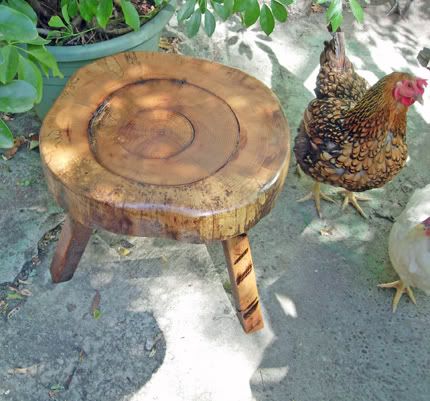
This is one of a pair of ash and white oak stools I did for the 2010 Monrovia fair. I had a bad feeling about the fair before hand and it proved to be so. It was a washout for me. So, I gave this stool to my brother for his birthday.
The top is a plate of ash from the same log I did the last set of stools from. I'll probably be able to get a few dozen stools out of it before I'm done. The legs are ripped from a roughsawn white oak 2x4 I salvaged. I only roughly smoothed and shaped them, leaving the major saw marks and signs of wear in place.
Ms Jaunty Beret, one of our gold wyandotte hens, came to supervise my photo session.
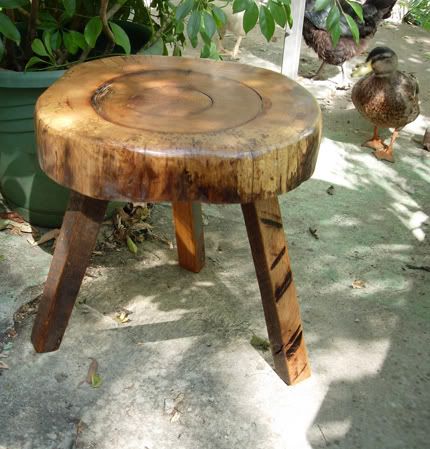
After Ms Jaunty Beret realized I had nothing to eat and left, her place was taken by Quaker Jack the mallard.
This is the same stool from a lower angle to show the legs a bit better. This stool has no stain, but several coats of spar urethane.
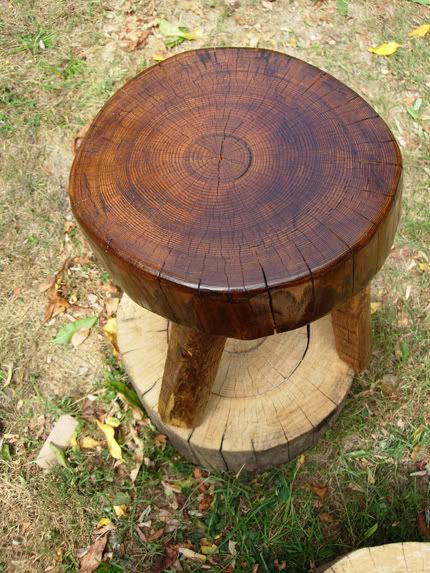
This stool is the one I thought would be interesting to rustic minded readers.
The stool is just like the one above, ash and oak, with a couple differances.
The legs are red oak instead of white. I cut them from an 8' 3x3 I found behind a dumpster in town. Probably from a shipping crate of some sort.
It's about an inch and a half taller than the stool at the top of the post, 18" surface height. This the most common height for dinning chairs.
The most interesting thing is the color though. I used no commercial stain on this stool. Instead I rubbed it directly with the green husks of black walnuts. The juice of the husks produce a powerful stain, and I've tried before to make a liquid stain from them, with limited success. This time I just twisted the husks off the nut and rubbed the juice into the wood by hand.
For the picture, I place the stool on top of a another section of ash from the same log, to show the difference in color between the unstained wood and the husk colored.
At first the stain colored the wood a yellow-green that wasn't so appealing. But I left the stool in the sun for a couple of days and it gradually changed into a very rich nut brown with gold high lights. I'm very pleased with the results.
I'm going to go collect enough walnuts for a big piece now. I'm thinking of a kitchen table. I'm still going to try and render or tincture the husks into a liquid base, but I have the feeling that I just won't get the deep color that hand rubbing with the husks has provided.
Thursday, September 2, 2010
A somewhat gothic wine crate lamp table.
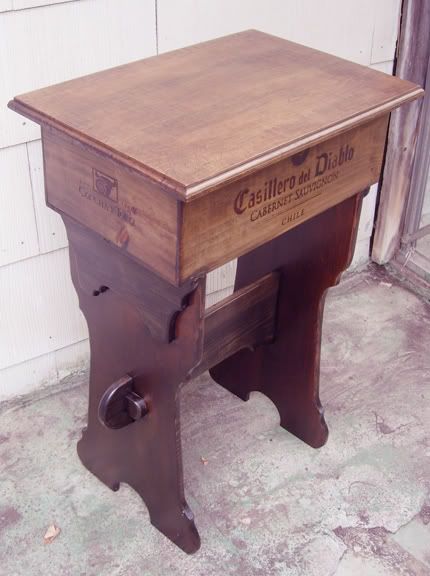
16" wide x 24" long x 34" tall. A lamp table is taller than an end table as it is meant to stand behind or beside a reading chair. It keeps the lamp higher than an end table to shed good reading light down on the book.
They also make good door side tables or entry way tables. You can put a basket or tray on an entry table to keep keys or serve as a catch all.
None of the three photos here quite have the correct color and tone of the actual table. The top and bottom are too light, and the middle is too dark. I used an old can of ebony stain that had solidified, and though I thinned it back to liquid, the change alters the texture and color of the stain.
I like it though. It's much darker than I usually go with, but I think it fits the shape of the trestle legs quite well.
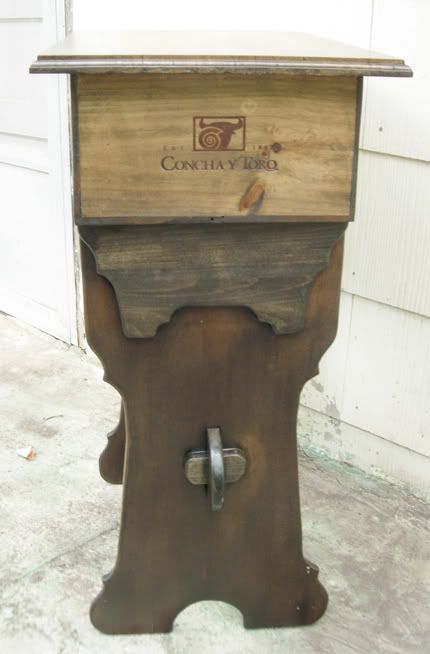
The top is made from an old and scarred maple cutting board. It took a lot of hand scraping with a broad chisel to remove the top layer of surface wood. I didn't want to plane it as I didn't intend to remove all the years of knife scars from it.
I went ahead and routed the edge to dress it up a bit. Maple really works cleanly, the routing is very sharp and defined.
I usually use old pine, poplar or oak for tops and they're much less apt to take a clean edge without a few extra passes.
This is the only crate I had for Cassilero Del Diablo, a Cabernet from Chile. Its shallower than most of the other crates I've collected and gives the table a less top heavy profile. In these pics is looks a bit leg heavy to me, but it doesn't appear so in person. A matter of perspective I suppose.
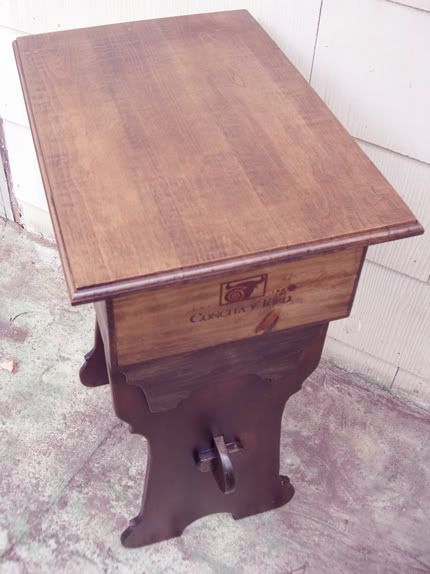
Wednesday, August 25, 2010
Poplar plank leg table.
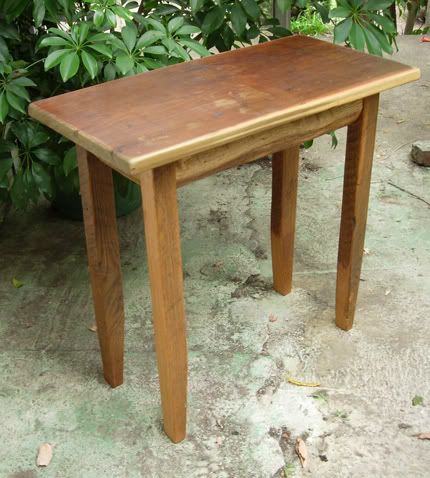
The top of this little table is a single piece of tulip poplar that once was a closet shelf in my grandmother's house. The plank was much older than the closet, which was an add-on to a room that was originally built without closets. The underside of the shelf was black with that soft, almost crumbly texture that poplar gets after 90 or so years undisturbed in the dark.
The legs are white oak. I ripped them down from a 2x4 salvaged from a friend's barn. Guess what an 8' white oak 2x4 costs today. You won't be doing any balloon framing with them, I can tell you.
The apron sections that join the legs are also white oak. I don't recall where I got the original piece from. It had a severe wain, the curve in the surface from cutting the plank from the edge of a log. Most of the time wainy lumber gets trashed or ground up for secondary uses, or used as stickers in shipping, but I thought It would look good as an apron with the wain turned down. And it does.
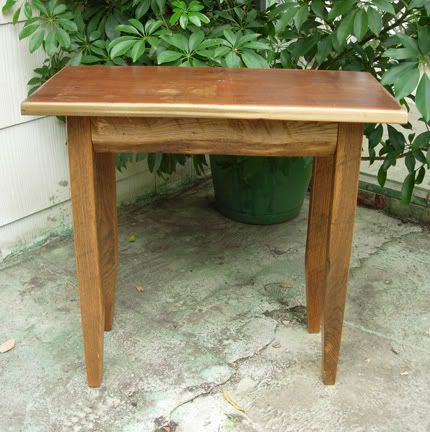
I took some of the bottom six inches of the legs off to make a slight inside taper. This tends to give the table a more visually pleasing look to the feet, and it also makes it stand more firmly. The less actual area of the foot touching the ground, the less likely it is to have any wobble.
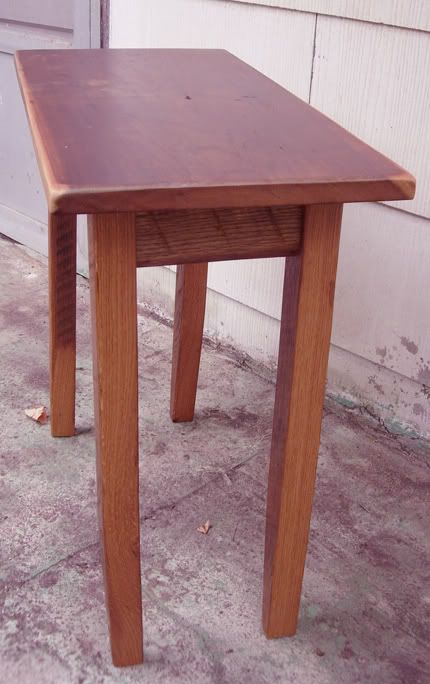
The table is 24" tall by 25" long and 12.5" wide. I gave the top a couple of coats of satin polyurethane but no stain. The wood already had so much color and character that stain would have been over kill.
The legs and the apron I gave a single coat of danish oil, and once that dried, one coat of satin poly over that.
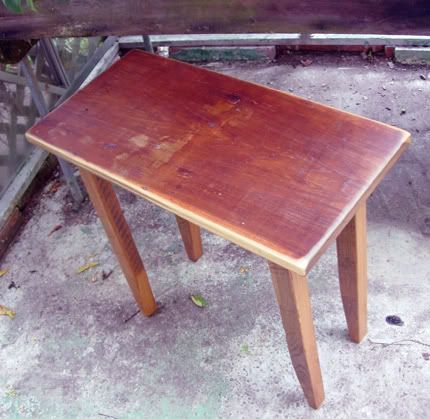
I did all cutting, sanding,and assembly on this table in about four hours. Not having to glue up a top or do any mortising for a trestle base made this very fast.
The finishing took a couple days, mostly just in the waiting for the coats to dry really.
The thing is, this is a table that is solid, functional, and richly characterful. It will be useful long after I'm gone, and it took negligable time and effort,(from my point of view). It recycles and reuses materials from before I was born and gives them a second life. I can't imagine why people go to Walmart and trade their money for slabs of particle board faced with plastic wood grain photos when this is possible. When you give money, the earning of which cost you time out of your life which you can never get back, for any shoddy cookie cutter product, you're actually destroying that little bit of wealth. Nobody is ever going to treasure as a family heirloom the $49.99 flatpacked coffee table you got at target.
Subscribe to:
Posts (Atom)



















